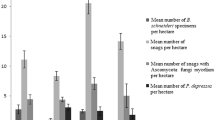Abstract
Taxus wallichiana Zucc. (Himalayan yew) represents one of the most threatened medicinal tree species of the Himalayan region. Heavy exploitation of its bark and leaves for taxol® has resulted in decline in its population. Generating quantitative information on Himalayan yew has therefore been stressed. The present paper provides information on the population and bark removal of Himalayan yew from one of the interior areas of Himalaya. Total count and quadrat method were deployed to generate quantitative information on its population while bark removal was estimated based on depth and extent of bark removed. After analyzing the existing information and the results of the study, a rapid vulnerability assessment (RVA) of the species was carried out. Taxus reported a density of 72 individuals/ha and was present as an under canopy of Picea smithiana. Complete stripping of bark was observed in 11 % of the Taxus population which amounted to ca. 18,152.86 cm3 of bark removed. The age class distribution showed complete absence of seedlings and saplings. RVA scores also reported higher values (26) thereby pointing toward the high vulnerability of this species. Across its entire distributional range, Taxus population is under severe pressure. It is high time when few patches of Taxus are demarcated as Medicinal Plant Conservation Areas, and detailed studies on its autecology are initiated.





Similar content being viewed by others
References
Badola, H. (2002). Medicinal plant diversity of Himachal Pradesh. In S. S. Samant, U. Dhar, & L. M. S. Palni (Eds.), Himalayan medicinal plants: potential and prospects. Himvikas occasional publication no. 14 (pp. 87–116). Nainital: Gynodaya.
Behera, M. D., Srivastava, S., Kushwaha, S. P. S., & Roy, P. S. (2000). Stratification and mapping of Taxus baccata L. bearing forests in Talle Valley using remote sensing and GIS. Current Science, 78, 1008–1013.
Behera, M. D., Kushwaha, S. P. S., Roy, P. S., Srivastava, S., Singh, T. P., & Dubey, R. C. (2002). Comparing structure and composition of coniferous forests in Subansiri district, Arunachal Pradesh. Current Science, 82(1), 70–76.
Cunningham, A. B. (1996). People, park and plant use: recommendations for multiple-use zones and development alternatives around Bwindi-Impenerrabie National Park, Uganda. People and plants working paper 4. Paris: UNESCO.
Farooquee, N., & Saxena, K. G. (1996). Conservation and utilization of medicinal plants in high hills of central Himalaya. Environmental Conservation, 23, 75–80.
Garcia, D., Zamora, R., Hodar, J. A., Gomez, J. M., & Castro, J. (2000). Yew (Taxus baccata L.) regeneration is facilitated by fleshy-fruited shrubs in Mediterranean environments. Biological Conservation, 95, 31–38.
Hulme, P. (1996). Natural regeneration of yew (Taxus baccata L.), microsite, seed or herbivore limitation? Journal of Ecology, 84, 853–861.
Iszkuo, G., & Boratynski, A. (2004). Interaction between canopy tree species and European yew Taxus baccata (Taxaceae). Polish Journal of Ecology, 52, 523–531.
Iszkuo, G., & Boratynski, A. (2005). Different age and spatial structure of two spontaneous subpopulations of Taxus baccata as a result of various intensity of colonization process. Flora, 200, 195–206.
Jaglan, M. S., & Thakur, B. R. (2006). Ecology of changing cropping pattern in Bharmaur tribal area of Himachal Pradesh. Journal of Human Ecology, 19, 13–20.
Jain, S. K., & Rao, R. R. (1976). A handbook of field and herbarium methods. New Delhi: Today and Tomorrow.
Kent, M., & Coker, P. (1992). Vegetation description and analysis. A practical approach. Chichester: Wiley.
Kumar, A., Sharma, C. M., & Baduni, N. P. (1994). Community structure and physical environment: a case study of the temperate mixed coniferous lata forest in the malaria valley of Garhwal Himalaya. Journal of Tropical Forest Science, 9, 449–457.
Lanker, L., Malik, A. R., Gupta, N. K., & Butola, J. S. (2010). Natural regeneration status of the endangered medicinal plant, Taxus baccata Hook. F. syn. T. wallichiana, in northwest Himalaya. International Journal of Biodiversity Science, Ecosystem Services & Management, 6, 20–27.
Magurran, A. (1988). Ecological diversity and its measurement. London: Croom Helm.
Mohapatra, K. P., Sehgal, R. N., Sharma, R. K., & Mohapatra, T. (2009). Genetic analysis and conservation of endangered medicinal tree species Taxus wallichiana in the Himalayan region. New Forests, 37, 109–121.
Nicolaou, K. C., Guy, R. K., & Potier, P. (1996). Taxoids: new weapons against cancer. Scientific American, 96, 84–88.
Pant, S., & Samant, S. S. (2008). Population ecology of the endangered Himalayan Yew in Khokhan wildlife sanctuary of North Western Himalaya for conservation management. Journal of Mountain Science, 5, 257–264.
Polunin, O., & Stantion, A. (1984). Flowers of the Himalaya. New Delhi: Oxford University Press.
Purohit, A., Maikhuri, R. K., Rao, K. S., & Nautiyal, S. (2001). Impact of bark removal on survival of Taxus baccata L. (Himalayan yew) in Nanda Devi Biosphere Reserve, Garhwal Himalaya, India. Current Science, 81, 586–590.
Rawat, J. S., Nimachow, G., Dai, O., Norbu, L., & Loder, T. O. (2011). Cancer of illegal trade threatens the anti-cancer Yews. Science and Culture, 77, 46–51.
Rikhari, H. C., Palni, L. M. S., Sharma, S., & Nandi, S. K. (1998). Himalayan yew: stand structure, canopy damage, regeneration and conservation strategy. Environmental Conservation, 25, 334–341.
Rikhari, H. C., Sharma, S., Nadeem, M., & Palni, L. M. S. (2000). The effect of disturbance level, forest types and associations on the regeneration of Taxus baccata: lessons from the central Himalaya. Current Science, 79, 88–90.
Sajwan, B. S., & Kala, C. P. (2007). Conservation of medicinal plants: conventional and contemporary strategies, regulations and executions. Indian forester, 133, 484–495.
Saniga, M. (2000). Structure, production and regeneration processes of English yew in the State Nature Reserve Plavno. Journal of Forest Science, 46, 76–90.
Saxena, A. K., Singh, S. P., & Singh, J. S. (1984). Population structure of forests of Kumaun Himalaya: implication for management. Journal of Environmental Management, 19, 304–324.
Shukla, G. P., Rao, K., & Haridasan, K. (1994). Taxus baccata in Arunachal Pradesh. Arunachal Forest News, 12, 1–7.
Singh, J. S. (1999). Man and forest interactions in Central Himalaya. In Anon (Ed.), Himalayan environment and development: problems and perspectives (pp. 57–79). Almora: GBPIHED.
Singh, J. S., & Singh, S. P. (1992). Forests of Himalaya. Nainital: Gyanodaya Prakashan.
Svenning, J. C., & Magard, E. (1999). Population ecology and conservation status of the last natural population of English yew Taxus baccata in Denmark. Biological Conservation, 88, 173–182.
Tittensor, R. M. (1980). Ecological history of yew Taxus baccata L. in Southern England. Biological Conservation, 17, 243–265.
Uniyal, S. K., Kumar, A., La.l, B., & Singh, R. D. (2006). Quantitative assessment and traditional uses of high value medicinal plants in Chhota Bhangal area of Himachal Pradesh, western Himalaya. Current Science, 91, 1238–1242.
Uniyal, S. K., Singh, K. N., Jamwal, P., & Lal, B. (2006). Traditional use of medicinal plants among the tribal communities of Chhota Bhangal, Western Himalaya. Journal of Ethnobiology and Ethnomedicine, 2, 14. doi:10.1186/1746-4269-2-14.
Ved, D. K., Kinhal, G. A., Ravikumar, K., Prabhakaran, V., Ghate, U., Vijay Sankar, R., & Indresha, J. H. (2003). Conservation assessment & management prioritization for the medicinal plants of Jammu & Kashmir, Himachal Pradesh and Uttaranchal. Bangalore: FRLHT.
Vishnu-Mittre. (1984). Floristic changes in the Himalaya (southern slopes) and Shiwaliks from the mid tertiary to recent times. In R. O. Whyte (Ed.), The evolution of the East Asian environment (pp. 483–503). Hong Kong: Center for Asian Studies.
Wild, R. G., & Mutebi, J. (1996). Conservation through community use of plant resources: establishing collaborative management at Bwindi impenetrable and Mgahinga Gorilla National Parks (pp. 1–45). Uganda: UNESCO. People and plants working paper 5.
Acknowledgments
Director IHBT is thanked for facilities. Dr. RD Singh is acknowledged for providing critical comments. Faculty and staff members of IHBT herbarium are thanked for discussions and guidance. Mr. Om Parkash and Varun Sharma are thanked for helping in the field. This is IHBT communication number 0885.
Author information
Authors and Affiliations
Corresponding author
Rights and permissions
About this article
Cite this article
Uniyal, S.K. Bark removal and population structure of Taxus wallichiana Zucc. in a temperate mixed conifer forest of western Himalaya. Environ Monit Assess 185, 2921–2928 (2013). https://doi.org/10.1007/s10661-012-2760-4
Received:
Accepted:
Published:
Issue Date:
DOI: https://doi.org/10.1007/s10661-012-2760-4




